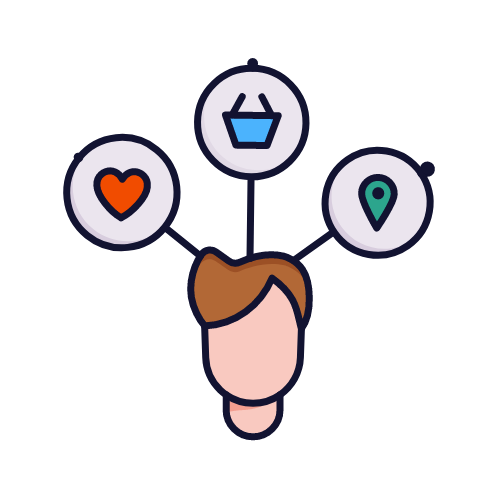Looking to increase your conversion rates through the second half of the year? Customized audience targeting is one of the smartest and most efficient ways to do it. And guess what—it’s not nearly as work-intensive as it sounds!
Whether you offer a service or a product, you’ve likely done the work to discover who your target audience is already. Knowing who your business relates to most helps you with everything from branding to knowing which marketing channels to focus on. It also helps you become a better marketer in the long run!
Unfortunately, many businesses neglect audience targeting on their own website when it comes to their conversion rates. This Wordstream blog, updated for 2023, shows that the average landing page conversion rate is just 2.35%. Today, we’re going to help you get 2x (or even 3x) the national average with improved conversion rate optimization (CRO) for your website.
What Is CRO?

You’ve likely heard the word ‘optimization’ when it comes to your website’s search engine ranking. Conversion rate optimization (CRO) takes a similar approach to converting more quality leads to customers on your website by meeting landing page design standards. At the bare minimum, your CRO efforts should include the following:
- Limited CTAs with one main focus per page
- Shortened forms
- Mobile-ready design
- Sound technical SEO (low page load speed, accessibility requirements met)
- A strong focus on reviews & social proof
- No other unnecessary distractions!
There is one common theme here, and that’s to eliminate hesitation. For example, removing multiple CTAs helps with decision paralysis, while shortening your forms removes the time for a lead to change their mind. Even something like a slow-loading page can send quality leads away!
From here, you may choose to add tools like heat mapping or screen recording to see where site visitors linger or click the most. Live chat is another great resource to help a lead convert when they still have lingering questions or concerns.
Did you know? Partnering with an agency like Brandography is a great way to gain access to these tools! Consult with a member of our team today!
After you have these essentials in place, you’ll be able to move forward with audience targeting to ensure the right people are viewing your website at the right time in their customer journey.
Here are our 3 key ways to go about your digital marketing targeting.
Target Audience #1: Demographic Targeting

We’ll begin with your most important audience targeting job, only because it’s something you’ve already put time into anyway!
While developing your product or service and bringing it to market, you likely identify who it’s for, when they might need it, and who they might want to tell about it. You’ve explored everything from age, gender, and lifestyle to other buyer persona attributes like hobbies, values, and average disposable income. If so, then you’ve already got a great foundation for your CRO!
However, if you’re saying “My business is for everyone, at all times, and for everyone they know”, you’re doing your business a disservice; high website traffic with zero conversions means nothing in the end (and may cost you more in lost marketing dollars). Instead, do the demographic targeting work necessary for both your overall marketing and to increase the CRO of your website.
To get started with demographic targeting, consider working on this checklist that we utilize ourselves:
- Analyze the data coming in from Google Analytics
- Perform a competitive analysis
- A/B test your website’s copy (headlines, layout), CTAs, and lead magnets (offers)
- Send out a survey email to your current customers
Once you’re in a good spot, you’ll be able to use demographic targeting on your website to improve your CRO in the following ways:
- Developing the proper lead magnet. Avoid a one-size-fits-all lead magnet by finding out what your website visitors actually want (and would happily trade their first-party data for). Offer a free analysis, free accessory add-on, or include an interactive element.
- Building a quality SEO strategy. The more you know about your target audience (and which of your competitors they might also be exploring), the more you can hone in on your keyword research, for instance.
- Creating a relevant email welcome series. If you can get your website visitors to return once via a solid welcome email, they’ll likely continue coming back more often!
- Displaying “personalized” recommendations. This works for both ecommerce stores and B2B education resources. Even if you don’t have their interests locked down, showing related content on each landing page tells your visitors that you have their best interests at heart.
- Targeting your high-value customers. Conversions don’t just need to happen once; in fact, a customer who converts multiple times should be your priority when it comes to improving your CRO! Find these people and continue to impress them with marketing that’s targeted to them.
- Segmenting your audiences. Use your lead magnet to start customers on a relevant flow vs. offering only one choice. This works well for websites that cater to multiple audiences, such as educators & students or medical providers & family members.
- Remarketing your audiences. A visitor won’t convert on your page right away? Remind them about your business by finding them elsewhere (Google, Facebook, YouTube, email) and remarketing your offer or website.
Note: A few of these practices may require additional tools to determine a traffic source, for example, or properly manage a site visitor’s cookies. If these seem out-of-reach for you or your team, Brandography can help!
Target Audience #2: Geographic Targeting

Though not as relevant in our global/always-online world, geographic targeting (or geo-targeting) is still a useful practice for delivering what your customers want, when they want it.
For instance, if you run a restaurant, geographic targeting is what you’ll use to invite people searching for a place to head out on a date. It’s also useful for out-of-towners needing to order out the night before a business meeting.
Other examples include clothing supply stores in ski towns or fishing tours for businesses along the coast. Those offering B2B services may also find geographic targeting useful for partnering with nearby businesses to offer local users a unique solution.
A great place to start with your geotargeting is on your Google Business Profile. Here, you can set up a radius and adjust advertising bids, optimize your long-tail keywords with phrases like “taquerias near me”, and respond to questions or reviews from customers to build your social proof. We have a few other tips for building a successful Google Business profile here.
You may also set up geotargeting in your social media ads on Meta or Google. Some of these tools even offer automated ways to reallocate your budget in regions where your ads are performing the best. In other words—don’t underestimate the power of geographic targeting!
Target Audience #3: Psychographic targeting

This one is relatively new to digital marketing targeting, though it’s become highly effective for modern-day marketers. Psychographic targeting is best used across larger segments of your target audience, stemming from the classic ‘buyer’s persona’ exercise.
For many leads and prospects, psychological motivations—rather than demographic or geographic—are a large driver of their online activity. If you have access to your leads’ activities, interests, and opinions (AIO), you have a good shot at determining their psychographic behavior. It’s the why to your demographic’s who and geographic where.
Now, to target these people with your website, you’ll want to finish building those buyer personas. Consider the following questions:
- What are your ideal customer’s activities & interests? Even better, try to write out a day in the life of your persona (and when they might fit in a visit to your site!)
- What are your ideal customer’s values? Are they family-oriented? Community-oriented? Eco-oriented?
- What are your ideal customer’s personality traits? In other words, how would their closest friends and family members describe them? Are they extroverted, funny, empathetic, or maybe a little neurotic?
- What are your ideal customer’s overall lifestyle choices? Do they eat out a lot? Is it healthy? Do they drive or try to bike everywhere?
You may also gather more concrete psychographic details from your current customers using the same practices as before. Study your website analytics, monitor your social media engagement, or complete an online or email survey or focus group.
From here, you can begin designing and building your website to attract, entertain, and—eventually—convert these ideal customers into real ones. Start with the specific psychographics of your buyer personas, then figure out what type of a segment they’d fall into. Then, as before, you can start researching more specific keywords, personalizing your campaigns and ads, or even reconsider your branding.
Unleash Our Brandography CRO Experts to Increase Your Website Conversions!
Of course, unlocking the secrets of better CRO doesn’t take an expert, but it does take time. It also takes well-rounded knowledge in a number of different digital marketing tactics. Knowing how to perform audience targeting is just one step in getting there. However, there are many additional steps to complete for the best CRO results.
For instance, our web developers work hand-in-hand with our content marketing and SEO experts to design, build, and continuously improve your website. Increased website conversions are our specialty, in fact, as they tie into all of the unique capabilities our Minneapolis digital marketing agency provides. You can see more about our results by visiting our case studies here.
Ready to get going on increased conversions right now? Reach out today to discuss where you’re blocked and we’ll offer ways we can help. From our expertise with audience targeting to building you a branded website, we think you’ll be pleased with the results you get with us for your unique business.



